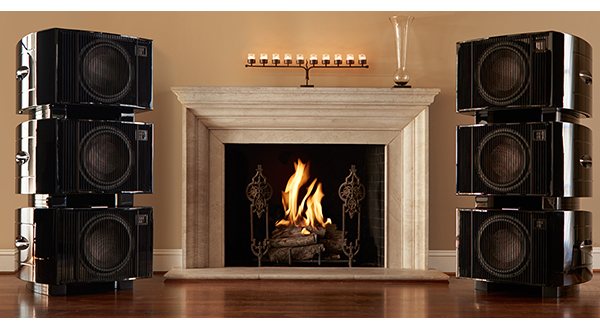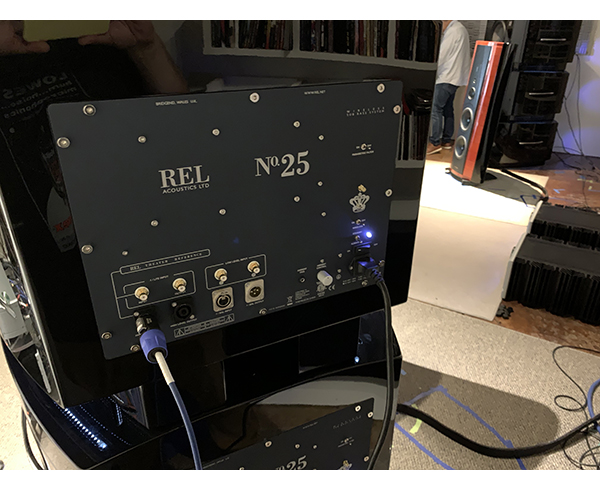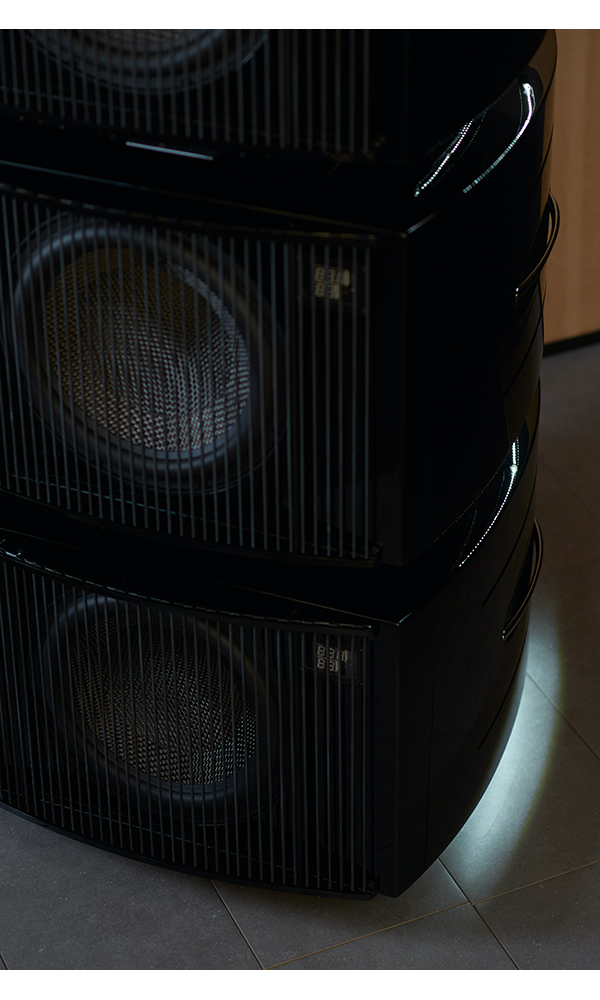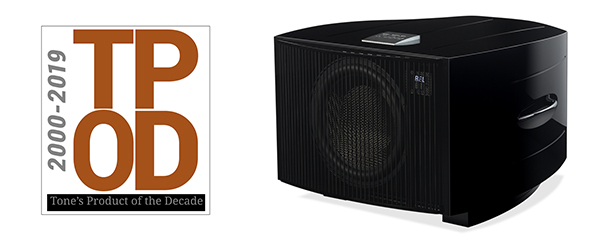The REL no.25 Six-Pack The World Beneath 40hz
By Jeff dorgay It only takes about eight seconds listening to a double stack of six REL no.25 subwoofers to realize that this is something completely otherworldly.
It only takes about eight seconds listening to a double stack of six REL no.25 subwoofers to realize that this is something completely otherworldly.
It’s not about sheer bass extension, though there’s plenty of that. The No.25 goes down to about 14 Hz (11 Hz in a well-dimensioned room) and will shake the room sufficiently if that’s the effect you seek. Go no further than your favorite electronica tracks to experience bass that goes beyond flapping your pants legs, or hitting you squarely in the gut. Winding out my reference system hard, really hard with a string of Aphex Twin tracks, both me and the Maxell man are peeling ourselves off the wall. But you can get this elsewhere.
What you can’t get elsewhere is low frequencies that feel real, rendered four dimensionally, with a true sense of height, depth, power, and texture. You don’t know where all of this perfectly rendered low frequency content is coming from – it merely exists. Just as it would if you were outdoors and heard a gunshot, an explosion, or a wall of sound from an outdoor PA system at a live concert.
The effect this will have on your reference system as well as what you thought a hifi system can accomplish is transformative. Combining the rest of my system with six REL No. 25s has brought an improvement that can’t be expressed in percentages. Before their arrival, I was listening to well recorded music on a premium hifi system, now I’m experiencing music that, if the recording is of the right caliber, it feels real. This level of improvement is nearly impossible to quantify.
More than a subtle shift
It’s one thing to make a pair of small speakers disappear in a room. It’s quite another to make six large cabinets, weighing 168 pounds each in a room vanish into thin air. Yet under the expertise of REL’s John Hunter (REL’s head designer who paid a visit to set them up properly) the dual stacks do just this in my listening room. It’s almost a Spinal Tap moment when they are optimized. “Yes, it’s all quite fearful, people run away screaming.” Something like that. The six pack of No.25s are a fundamental shift in what I believed was possible in a music system.
 Nearly eight months after the six-pack has been installed, it remains tough to concentrate on two things at once, so I default to just listening. The musical experience is so much different, so much more involving that what I’ve been used to, my point of reference is now reset. Unlike other components that thrill out of the box, only to fade with familiarity, if anything I’m more engaged and excited about listening to music than I have ever been, as a result of the six pack being part of my system. Though the word magic is often overused in the context of product reviews (of any kind) something supernatural is going on here.
Nearly eight months after the six-pack has been installed, it remains tough to concentrate on two things at once, so I default to just listening. The musical experience is so much different, so much more involving that what I’ve been used to, my point of reference is now reset. Unlike other components that thrill out of the box, only to fade with familiarity, if anything I’m more engaged and excited about listening to music than I have ever been, as a result of the six pack being part of my system. Though the word magic is often overused in the context of product reviews (of any kind) something supernatural is going on here.
More than excursion
The first thing guests say when they walk in the room is usually a comment about how much bass these must produce, or “do you really need six subwoofers?” The answer to the latter question is an unquestioned “Yes”. The answer to the first question is more complex.
Initial shock aside, what happens on a regular basis at modest listening levels, the reaction to the REL no.25s is one of overwhelming emotional involvement and connection to the music. It usually involves tears, and even a bit of outright sobbing. That’s the connection to music and the REL stack’s true power. Watching someone listen to one of their favorite pieces of music, perhaps one that’s been heard hundreds, if not thousands of times before, come way out of their comfort zone and just tear up – uncontrollably – is pretty amazing. These 6 No.25 are the final step in making the illusion real.
But even this still isn’t the full story, either. What six REL No.25s do is bring your hifi system to life in a way that is not possible without them. Performing Mr. Hunter’s favorite demo of listening to a piece of music, even one with modest low-frequency content, and then quickly shutting the subs off with the 212SEs that were my past reference is one thing. I immediately want to turn the 212s back on, their contribution significant.
Shutting off the six No.25s is what I imagine quitting heroin cold turkey must be like. The world is no longer right and I just want another fix. Yep, it’s that good. It’s that powerful. Great as one or two No.25s can be, the stack is where it’s at. It’s that much of a buzz.
The secondary shock, if you will, is just how much low frequency content lurks in so many records that I thought I knew inside and out. Even after living with a pair of REL 212SEs and before that the mighty GamuT S9s, which went down deep. Between about 12,000 ripped CDs, a few thousand LP’s and all the new music I’m either discovering or revisiting on Tidal and Qobuz, I’d be lying if I told you I’ve gone through my entire collection.
More than dynamics
The six low-mass/high excursion 15-inch carbon fiber drivers in the REL no.25s, are each powered by a 1000-watt Class-D amplifier that has been refined over a few generations of REL subwoofers. Mr. Hunter tells me that this amplifier was chosen strictly on sonic and reliability parameters, as they use both Class-D and AB amplifiers for their products. “It’s simply the best tool for this application.” You can read the full specifications of the no.25 here.
However, with this much power and cone excursion at your beck and call, it’s questionable that you will ever use most of it. The benefit at normal levels is the elimination of any distortion or smearing of the sound field being generated. It’s truly amazing at how much low frequency content is present at conversation levels. Neither the drivers nor the amplifiers are being stressed at all, and this sense of ease is what paints such a broad sonic picture.
Where other manufacturers have looked at a subwoofer to extend the frequency response and move a lot of air, the lack of resolution is what always makes them sound like an afterthought. This is what gives you that feeling of hearing those two boxes on the floor, thumping along. This is not the REL way of doing things.
The resolution is the solution
What this all adds up to is a bass system that is built to the same level of excellence that your main speakers are, if not better. Considering that the majority of the energy present in music is in the lower registers, doesn’t it make perfect sense that this is where the attention be paid?
Once the RELs are in place, set up and properly matched to your room and main speakers, even music without high levels of apparent LF energy take on more depth, more life. Common audiophile terms like pace and timing take on new meaning. Should you take the plunge, you’ll notice even the most average recordings in your collection have all become so much more listenable, and the best recordings will fix you in your listening couch or chair to the point that hours will slip away.
And, you just might be surprised how much spatial information is lurking in recordings you thought you knew. It’s not all just way up on the top end of the musical spectrum. This was the biggest revelation of having these subwoofers now part of my system. And with every kind of music. Even well worn Electronica/EDM/Ambient tracks, that use no real instruments still felt way more alive, while acoustic recordings now have so much more realism. Again, listening to someone play a stand up bass in the context of a small club feels correct, yet that last bit of harshness and screechiness that usually accompanies a violin or viola via a pair of speakers vanishes too.
Once optimized and broken in, the REL six pack will have you rediscovering your entire music collection. Cliché but true.
Mr. Hunter is busy writing a detailed blog on setup of the No.25 Line Arrays. A link will be posted shortly on Tone Audio for those interested in learning how to dial-in their Line Arrays. Suffice it to say, those familiar with the basics of REL setup and dial-in will have a solid grounding in the listening tools needed. But the obvious need for a meticulous, methodical approach when dealing with 6 units totaling over 1,000 pounds, 6,000 watts and over 1,000 square inches of driven surface area necessitates having a solid game when it comes to the finer aspects of pulling a 6-pack together. As always, John Hunter will deliver all the fine points needed to help his customers and especially his dealers achieve the kind of performance expected from a ne plus ultra product such as this.
As someone who started the serious part of their audio journey with Quads 57s, MartinLogan CLS, Acoustat and Magnepan speakers, it’s easy for someone with my built-in bias to minimalize the importance of low frequency content done right. “Me, I’m all about the imaging and soundstage.” “I prefer the transparency of a panel speaker and bass just isn’t that important.” And the well repeated, “you can’t really get a sub to keep up with a panel speaker.” You know the excuses. And hey, you lovers of small mini-monitors are guilty of the same sins.
For those living in the past with their heads in the sand of 1985, yes. But it’s 2020 (for all practical purposes) and there are more than a few excellent cone speakers offering incredible imaging, tonality, delicacy, and dynamics. They even provide decent low frequency reproduction, some very good. However, subwoofers have made similar advancements, and it is possible to get more bass extension in a more unobtrusive way.
Like nearly everything offering high performance, and a high degree of craftsmanship, the best of the best still costs extra – and justifiably so. A six pack of REL no.25 subwoofers is by no means overkill, especially once you’ve had the experience. Many of you know the obvious advantage of two subwoofers versus a single – it allows you to optimize the bass output in your room so much more evenly than a single one can, and also allows more bass excursion with less distortion than a single subwoofer can provide.
The key to this extroadinary experience, is the way the array interacts with the room and the main speakers. The array connects to your main speaker system via a high level Speakon connection at the speaker terminals. This helps the subs to accurately mirror the sonic signature of your amplification chain, as well as letting your main speakers run full range.
This would be where a regular REL subwoofer would pick up, but with the array, each of the three subs per channel is optimized to a slightly different output level, crossover frequency and fine adjustment of the filters, so that each can blend with the room and main speakers perfectly. Your REL dealer will facilitate delivery and setup to perfection.
Justification
One, or even two REL no.25s, at $7,500 each is probably not going to be an idle purchase. And while you might think $45,000 is just crazy for a set of six of these, in the context of a system built to take advantage of what they can bring to the table, the percentage of total system cost is probably going to be between 10-20% of your total system investment.
Looking at this from a cost/benefit analysis, like the pair of REL 212SEs that used to be my reference, the amount of performance gained in relation to the rest of the system is off the chart good. As a comparison, I have heard the Wilson Audio Thor’s Hammer on numerous occasion (about $50k/pair, without crossover and amplifiers) and I feel a six pack of REL no. 25s exceed the ability of the Hammers in every possible parameter – which makes the REL stacks a stone cold bargain. Especially considering that when playing in this league, a highly advanced audio enthusiast could easily spend way more than this on cable or a couple of equipment racks which might bring a few percentage points of improvement in the scheme of things.
A single REL no.25, or even a pair, is the finest subwoofer I’ve heard. But the six pack is in a class by itself. There’s nothing to compare them to. The level of realism that they bring to a world class system is unmatched. That is why the REL no.25 six pack is more than deserving of one of our first ever Product of the Decade awards. This is the new benchmark, indeed it is the missing link in our systems, not just for low frequency reproduction but for dissolving the boundary between recorded music and physical reality happening in one’s own home. And there’s no other way to get it.
The REL no.25 six pack
$45,000
www.rel.net
Peripherals
Preamplifier Pass Labs XSPre
Digital Source dCS Vivaldi One
Analog Source GrandPrixAudio Parabolica Turntable/TriPlanar Arm Koetsu Jade Platinum
Amplifier Pass Labs XA200.8 Monoblocks
Speakers Sonus faber Stradivari (35th anniv. edition)
Cable Cardas Clear, Tellurium Q Reference





